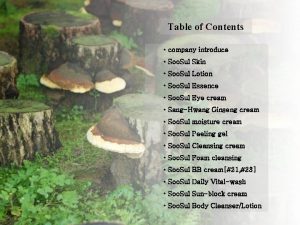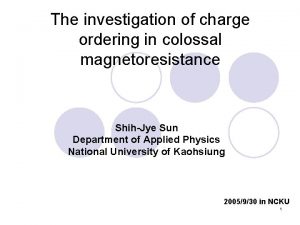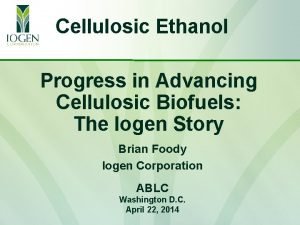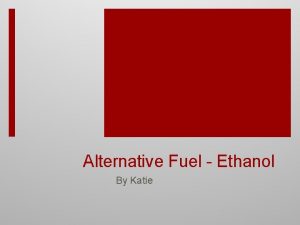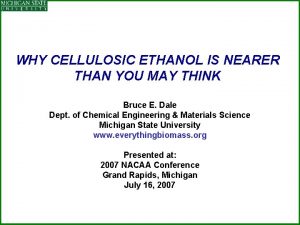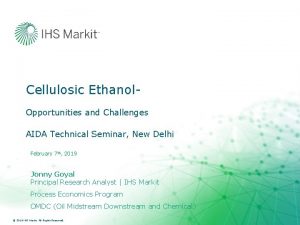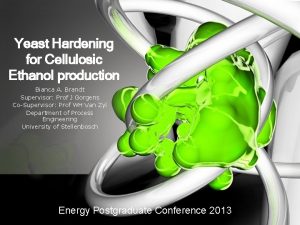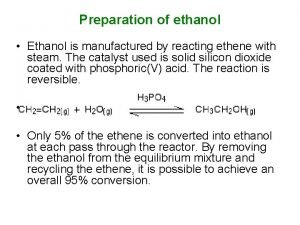Cellulosic Ethanol InChul Hwang What is Cellulosic Ethanol












- Slides: 12

Cellulosic Ethanol In-Chul Hwang

What is Cellulosic Ethanol? Ethanol made from cellulosic biomass which comprises the stems and branches of most plants n Feedstock of cellulosic ethanol is various - Crop residues: corn stalks, wheat straw - Wood waste: wood chip - Municipal solid waste - Dedicated energy crops: switchgrass, poplar n

Why Cellulosic Ethanol? (1) Conventional ethanol has food vs. fuel problem - Its main feedstock is also used for food - Increasing crop ethanol production is competing for land with food production - Some argue that ethanol can worsen world food shortage and raise food price - Crop ethanol can improve energy security but worsen food security n It has limit in large-scale production - US corn ethanol production is likely to top out around 12 billion gallons a year n

Why Cellulosic Ethanol? (2) It can solve this food vs. fuel controversy - Its feedstock (switchgrass, poplar) is not edible - It can grow on marginal lands. It will not divert land from food production to its production n It has a wide range of feedstock - It can replace fossil fuel in significant scale. 30% of US transportation fuel can be supplied by cellulosic ethanol n It has higher yield/acre without land limit - It can be used as a whole unlike crop ethanol - It doesn’t need specific climate or land so that it can be produced in every region of the US n It has better GHG reduction potential n

Production Process (1) Currently “Hydrolysis” process is dominant 1. Pretreatment: make biomass amenable to hydrolysis. Hemicellulose and/or lignin is removed and cellulose structure is modified 2. Hydrolysis: break down the cellulose into glucose sugars by adding enzyme 3. Separation: separate sugar solution from the residual lignin 4. Fermentation: ferment the sugar solution by adding bacteria/yeast 5. Distillation: distill beer (mixture of ethanol, cell mass, water) to produce pure ethanol n

Production Process (2) Source: Biotechnology Industry Organization, 2007

Production Cost n n n Currently cost of cellulosic ethanol is far higher than those of gasoline and corn ethanol The higher cost is due to higher capital cost and operating cost. Feedstock cost is comparatively low If the constructions of several large-scale commercial plants are completed in years, the production cost will decrease. Source: IEA, 2004

Current Status-Technology Production cost has constantly declined over the past five years with improvement in biotechnology n Developing cost-effective enzymes will be a key breakthrough to commercialization. n In 2004, Iogen Corporation announced it began the commercial production of cellulosic ethanol. n

Legislation and Policy Energy Policy Act of 2005 - RFS: requires 250 million gallons of cellulosic ethanol beginning in 2013 - Biorefinery loan guarantee: $250 million/facility for the construction of demonstration plant - Biorefinery grant: $650 million for the commercial production of cellulosic ethanol n 2006 Advanced Energy Initiative includes research funding to produce cellulosic ethanol at competitive cost by 2012 n In 2007, 6 commercial-scale cellulosic ethanol plants were selected for $385 million grant. n

Future Prospect EIA predicts ethanol consumption will reach 11 billion gallons by 2012, far above 7. 5 billions gallons required by Energy Policy Act of 2005. n Oil Price is expected to keep rising - Now crude oil is nearing $100/bbl n 2007 energy bill requires 36 billion gallons of biofuels by 2022. - It mandates annual increases of 3 billion gallons in the use of advanced biofuels n

Conclusions Current ethanol boom caused by strong support policy, high oil price will eventually lead to cellulosic ethanol on the market n Mandatory flex-fuel requirement for new vehicles and nation-wide ethanol pump stations are needed for large-scale use of cellulosic ethanol n Cellulosic ethanol will have synergy effect if combined with PHEV - If all ground vehicles were suddenly flex-fuel PHEV→ they can replace 97% of current ground transportation n

References 1. 2. 3. 4. 5. 6. 7. 8. IEA, 2004, “Biofuels for Transport: An International Perspective” ttp: //www. iea. org/textbase/nppdf/free/2004/biofuels 2004. pdf Science vol. 315, 16 March 2007 “Biofuel researchers prepare to reap a new harvest” http: //www. doe. gov/print/4827. htm RFA, 2006, “ From niche to nation: ethanol industry outlook 2006” http: //www. ethanolrfa. org/objects/pdf/outlook_2006. pdf DOE press release, February 28, 2007 http: //www. doe. gov/print/4827. htm Biomass & Bioenergy 28 (2005) 384 -410 “Ethanol from lignocellulosic biomass: techno-economic performance in short-, middle- and long-term” Biotechnology Industry Organization, 2007 “Industrial biotechnology is revolutionizing the production of ethanol transportation fuel http: //www. bio. org/ind/biofuel/Cellulosic. Ethanol. Issue. Brief. pdf Ron Gremban, 2006, “PHEVs: the Technical Side “ www. calcars. org/calcars-technical-notes. pdf







